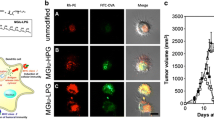Abstract
Purpose. The aim of the study was to encapsulate a model protein antigen, tetanus toxoid (TT), within hydrophobic (PLA) and surface hydrophilic (PLA-PEG) nanoparticles and to evaluate the potential of these colloidal carriers for the transport of proteins through the nasal mucosa.
Methods. TT-loaded nanoparticles, prepared by a modified water-in-oil-in-water solvent evaporation technique, were characterized in their size, zeta potential and hydrophobicity. Nanoparticles were also assayed in vitro for their ability to deliver active antigen for extended periods of time. Finally, 125I-TT-loaded nanoparticles were administered intranasally to rats and the amount of radioactivity recovered in the blood compartment, lymph nodes and other relevant tissues was monitored for up to 48 h.
Results. PLA and PLA-PEG nanoparticles had a similar particle size (137-156 nm) and negative surface charge, but differed in their surface hydrophobicity: PLA were more hydrophobic than PLA-PEG nanoparticles. PLA-PEG nanoparticles, especially those containing gelatine as an stabilizer, provided extended delivery of the active protein. The transport of the radiolabeled protein through the rat nasal mucosa was highly affected by the surface properties of the nanoparticles: PLA-PEG nanoparticles led to a much greater penetration of TT into the blood circulation and the lymph nodes than PLA nanoparticles. Furthermore, after administration of 125I-TT-loaded PLA-PEG nanoparticles, it was found that a high amount of radioactivity persisted in the blood compartment for at least 48 h.
Conclusions. A novel nanoparticulate system has been developed with excellent characteristics for the transport of proteins through the nasal mucosa.
Similar content being viewed by others
REFERENCES
A. T. Florence. Pharm. Res. 14:259–266 (1997).
H. O. Alpar, J. C. Bowen, and M. R. W. Brown. Int. J. Pharm. 88:335–344 (1992).
D. T. O'Hagan. Clin. Pharmacokinet. 22:335–344 (1992).
P. Wüthrich and P. Buri. Pharm. Acta Helvetiae 64:322–331 (1989).
A. E. Pontirolli. J. Control. Rel. 13:247–251 (1990).
A. J. Almeida and H. O. Alpar. J. Drug Targ. 3:455–467 (1996).
C. F. Kuper, P. J. Koornstra, D. M. H. Hameleers, J. Biewenga, B. J. Spit, A. M. Duijvestijn, P. J. C. van Bedra, and T. Smimia. Immunol. Today 13:219–224 (1992).
E. Abraham. Vaccine 10:461–468 (1992).
J. C. Bowen, O. Alpar, R. Phillpots, I. S. Roberts, and M. R. W. Brown. J. Lipos. Res. 5:193–214 (1995).
A. J. Almeida, H. O. Alpar, and M. R. W. Brown. J. Pharm. Pharmacol. 45:198–203 (1993).
J. H. Eldridge, C. J. Hammond, J. A. Meulbroek, J. K. Staas, R. M. Gilley, and T. R. Tice. J. Control. Rel. 11:205–214 (1990).
R. Gref., Y. Minimitake, M. T. Perracchia, V. Trubetskoy, V. Torchilin, and R. Langer. Science 263:1600–1603 (1994).
M. T. Peracchia, R. Gref, Y. Minimitake, A. Domb, N. Lotan, and R. Langer. J. Control. Rel. 46:223–231 (1997).
Y. Minimitake, R. Gref, J. S. Hrkach, M. T. Peracchia, A. Domb, and R. Langer. Macromolecules (Submitted).
M. D. Blanco and M. J. Alonso. Eur. J. Pharm. Biopharm. 43:287–294 (1997).
H. Carstensen, B. W. Muller, and R. H. Muller. Int. J. Pharm. 67:29–37 (1991).
M. J. Alonso, S. Cohen, T. G. Park, R. K. Gupta, G. Siber, and R. Langer. Pharm. Res. 10:945–953 (1993).
A. E. Hawley, L. Illum, and S. S. Davis. Pharm. Res. 14:657–203 (1997).
M. J. Alonso, B. Villamayor, M. Tobío, S. Schwendeman, R. K. Gupta, G. Siber, and R. Langer. Proceed. Intern. Symp. Rel. Bioact. Mater. 23:825–826 (1996).
M. Tobío and M. J. Alonso. Proceed. Intern. Symp. Rel. Bioact. Mater. 24:425–426 (1997).
D. Bazile, C. Prud'homme, M. T. Bassoulet, M. Marlard, G. Spenlehauer, and M. Veillard. J. Pharm. Sci. 84:493–498 (1995).
S. Stolnik, S. E. Dunn, M. C. Garnett, M. C. Davis, A. G. A. Coombes, D. C. Taylor, M. P. Irving, S. C. Purkiss, T. F. Tadros, S. S. Davis, and L. Illum. Pharm. Res. 11:1800–1808 (1994).
A. T. Florence and P. U. Jani. Pharmaceutical Particulate Carriers, Marcel Dekker, New York, 1993, pp. 65–108.
H. O. Alpar, A. J. Almeida, and M. R. W. Brown. J. Drug Targeting 2:147–149 (1994).
Author information
Authors and Affiliations
Rights and permissions
About this article
Cite this article
Tobío, M., Gref, R., Sánchez, A. et al. Stealth PLA-PEG Nanoparticles as Protein Carriers for Nasal Administration. Pharm Res 15, 270–275 (1998). https://doi.org/10.1023/A:1011922819926
Issue Date:
DOI: https://doi.org/10.1023/A:1011922819926




